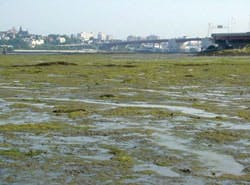The Unhealthy Greening of Maine’s Casco Bay
When it rains in Maine, dangerous chemicals run off the ground and into the clamflats and beaches of Casco Bay. Volunteers and staff from Friends of Casco Bay (FOCB), a nonprofit marine stewardship organization, are sampling the drains and waterways that lead to the bay. The group has found high concentrations of nitrogen and phosphorus in water samples taken after storms. Once these nutrients enter the bay, they can contribute to an explosion of nuisance algae and deplete dissolved oxygen in the water.
The waters of the bay should be blue and its beaches and mudflats brown, but volunteers are now seeing a sea of green instead. Nitrogen pollution has led to visible growth of slimy green algae that smothers clamflats and contributes to red tides, fish kills and marine mammal deaths.
“The health of Maine depends on the health of our marine waters,” said Will Everitt, development director for FOCB. “Casco Bay has some of the largest clam and lobster landings in the state. It also has the busiest oil port on the East Coast, and its watershed is home to one-quarter of the state’s population.”
Funded in part by a $10,000 Minding the Planet grant from the YSI Foundation , the organization is collecting extensive data on nitrogen, dissolved oxygen, pH and chlorophyll levels at more than 50 sites around the bay. FOCB is using YSI data sondes to measure the changing water quality.
FOCB is working with local citizens to find ways to reduce nutrient discharge into Casco Bay. Its outreach programs include ecological landscaping seminars, handouts explaining the effects of fertilizers and pesticides on the watershed and providing suggestions for alternative lawn care practices.
To further address nutrient pollution, FOCB is:
- Keeping pressure on municipalities to remove combined sewer overflows (CSOs), which mix storm water with raw sewage. Both storm water and sewage contain nitrogen.
- Making sure large passenger ships comply with Casco Bay's newly designated “No Discharge Zone,” which prohibits discharging treated and nontreated sewage into the bay.
- Supporting the implementation of legislation passed in 2007 to establish nutrient standards for Maine's coastal waters.
The overall goal is to stop the “rise of slime” that is threatening Maine’s coastal areas. While nutrients are necessary to support living organisms, what people need to realize is that “too much of a good thing is a problem for the Bay,” Everitt said. “We have an opportunity to stop the effects of nutrient pollution before it becomes irreversible.”
| Related Searches from WaterInfoLink.com Casco Bay | Algae | YSI | Combined Sewer Overflows (CSOs) | Nutrient removal |
